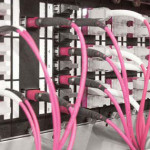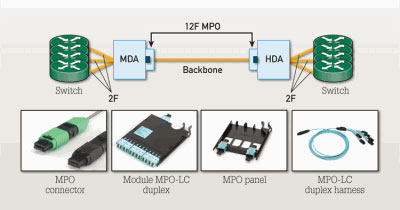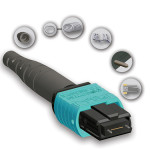1G and 10G data rates are not adequate to meet the future needs of high-bandwidth appli- cations. The requirement for higher data rates is being driven by many factors. Switching and routing, virtualization, convergence and high-performance computing environments are examples of where these higher network speeds will be required within the data center environment. Additionally, Internet exchanges and service provider peering points and high-bandwidth applications, such as video-on-demand will drive the need for a migration from 10G to 40/100G interfaces.
Bandwidth
OM3 and OM4 fibers were selected as the only multimode fiber for 40/100G consideration. The fibers are optimized for 850 nm transmission and have a minimum 2000 MHz∙km and 4700 MHz∙km effective modal bandwidth (EMB), respectively. Two EMB measurement techniques are utilized today for the bandwidth measurement. The minimum effective modal bandwidth calculated (EMBc) method offers the most reliable and precise measurement compared to the differential modal delay (DMD) mask technique. With minEMBc, a true scalable bandwidth value is calculated that can reliably predict performance for different data rates and link lengths. With a connectivity solution using OM3 and OM4 fibers that have been measured using the minEMBc technique, the optical infrastructure deployed in the data center will meet the performance criteria set forth by IEEE, Fibre Channel and InfiniBand for bandwidth.
Insertion Loss
Insertion loss is a critical performance parameter in current data center cabling deploy- ments. Total connector loss within a system channel impacts the ability of a system to operate over the maximum supportable distance for a given data rate. The 40/100G Ethernet standard specifies the OM3 fiber 100 m distance maximum channel loss to be 1.9 dB, which includes a 1.5 dB total connector loss. The OM4 fiber 150 m distance maximum channel loss is 1.5 dB, which includes a 1.0 dB total connector loss budget.
The insertion loss specifications of the MPO connectivity components should be evalu- ated when designing data center cabling infrastructures. With low-loss MPO connectivity components, maximum flexibility can be achieved with the ability to introduce multiple connector matings into the connectivity link such that structured cabling architectures can be supported.
Skew
The IEEE 802.3ba standard includes an optical media skew of 79 ns. Optical skew, the difference in time of flight between light signals traveling on different fibers, is an essential consideration for parallel optics transmission. With excessive skew, or delay, across the various channels, transmission errors can occur. Skew testing on MPO connectivity solu- tions has demonstrated compliance to a strict 0.75 ns skew requirement as defined in the InfiniBand standard. Deployment of a connectivity solution with strict skew performance ensures compatibility of the cabling infrastructure across a variety of applications. When evaluating optical cabling infrastructure solutions for 40/100G applications, selecting one that meets the 0.75 ns skew requirement ensures performance not only for 40/100G, but also for InfiniBand. Additionally, low–skew connectivity solutions validate the quality and consistency of cable designs and terminations to provide long-term reliable operation.








